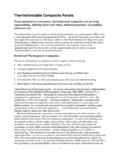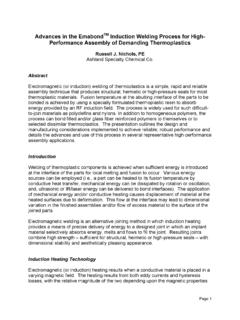Transcription of 5 Calculations for Structures under Mechanical Load ...
1 5 Calculations for Structures under Mechanical Load . Examples of Geometrically Simple Structural Parts under Static Loads Specific Materials and Processing Problems The Mechanical properties of polymeric materials, especially those of thermoplastics, depend to a much greater extent on temperature, time, and on the magnitude and nature of an applied load than those of metals. In addition, many environmental effects, such as UV radiation or exposure to certain chemicals, play a significant role in aging and related changes in properties. This can be difficult to quantify in strength-related Calculations . The conditions used in processing ( , injection molding process) can have an effect on the properties of the finished product. Because the strength of most polymeric materials is an order of magnitude less than that of metals, components made from these materials may be highly stressed even under relatively low loads.
2 On the other hand, a component made from a polymeric material is more likely to be rendered unusable by a high degree of deformation than by catastrophic failure due to fracture (in the case of ductile polymeric materials). The modulus of elasticity of these materials differs by as much as two orders of magnitude. The complexity of deformation behavior, however, leads to the expectation that deformation can only be calculated precisely with the aid of computer support and that the empirical determination of physical properties for this purpose will be very costly. There are, however, a limited number of design tasks for which such extensive design work is necessary. Not all designers have the extensive knowledge required to optimize structural elements with the aid of FEM.
3 This task is best performed by an engineer who specializes in computer aided finite element structural design. However, there are a large number of applications where routine structural design Calculations can be done by the average designer to help determine optimum part geometry. These are carried out using justifiable simplifications [ ]. Knowledge of some specific properties of polymers is needed for this purpose. Deformation Behavior under Uniaxial Dynamic Tensile Stress The deformation of polymeric materials under the action of an external force, can be described by three components, which to some extent are superimposed, but at the same time predominate in certain ranges of deformation (see also Section ). Linear elastic, spontaneously reversible deformation is restricted in most polymeric materials to a total strain range of less than one tenth of one percent.
4 This marks the end of the range of applicability of Hooke's law of elasticity for many polymeric materials. Most strains observed 176 5 Calculations for Structures under Mechanical Load [References on Page 211]. in practice exceed this range. In many unreinforced thermoplastics, it is not even possible to demonstrate (by way of stress-strain experiments) the existence of a range in which Hooke's law is obeyed. As strain increases, visco-elastic deformation processes appear. These are said to fall into the linear visco-elastic range when the laws of linear visco-elasticity apply. This range is characterized in that two strains 1 and 2 may be added when the corresponding stresses 1 and 2 are superposed (Boltzmann's law of superposition). 1 1. 2 2 ( ). 1 + 2 = 1 + 2.
5 In isochronous stress-strain diagrams, this range is marked by the end of the straight-line rise of the isochrones. This range also ends for most polymeric materials at stresses which cause strains of to 1%. As strain increases further, the relationship of stress to strain no longer depends only on time (and of course on temperature), bur rather on the applied stress itself. The deformation processes become increasingly nonlinear and also irreversibly (or partially irreversibly) viscous. These deformation phenomena found at the macroscopic level are characterized by the molecular deformation and damage mechanisms occurring in the material (see also Chapter 4). In some applications, thermoplastic polymeric materials are subjected to loads which take them into the nonlinear stress-strain range.
6 As a result, Calculations based on the laws of elasticity inevitably yield results which diverge to a greater or lesser extent from actual behavior. As long as the stresses are at least close to the linear viscoelastic range, the formulae of the theory of elasticity afford a satisfactory degree of accuracy. Therefore, their use is certainly justifiable and may indeed be essential, based on time available and on economic grounds. In addition, the calculation of structural elements made from polymeric materials is rendered more difficult and uncertain due to the fact that the condition of a homogeneous, isotropic continuum is not fulfilled. Here, the different types of anisotropy should be taken into account whenever possible ( , when anisotropic data is available).
7 The causes of these may lie in the material itself (reinforcement by unidimensional fibers, for instance) or be due to processing. Examples of the latter include residual molecular alignments and internal stresses imposed during the molding operation (see also Chapters 2 and 7). Internal stresses can be caused by impediments to shrinkage in macroscopic domains. A number of primary causes of internal stress may be distinguished. Cooling internal stresses are the result of different rates of cooling over the cross section of the molding. Holding- pressure related internal stresses are due to the holding pressure acting in the interior of the molding in the injection molding process when the outer contours have already solidified. Embedding internal stresses arise from shrinkage impeded by the shape of the molding due, for example, to metal inserts or due to the constraints imposed by the shape of the mold itself.
8 Secondary internal stresses are also known. These include structural internal stresses brought about by curing reactions (in thermosets) or crystallization (in semi-crystalline thermoplastics). Embedding internal stresses can be produced, for example, by the incorporation of fillers. Determination of Strength 177. Cooling internal stresses give rise to compressive stresses on the surface of the molding. These compressive internal stresses can have a positive effect in the event of tensile loads in the outer zone ( , during bending). On the other hand, excessive holding pressure causes compressive internal stresses in the interior of the molding and tensile internal stresses in the outer zone. These are superimposed on the cooling internal stresses so that when the holding pressure is high enough, tensile internal stresses may also be apparent on the surface of the molding.
9 These internal stress states, which are also very difficult to describe quantitatively, represent a further uncertainty factor in Calculations of strength. Determination of Strength Basic Procedure for Structural Part Design The basic procedure for structural part design is given in Figure An analysis of stress provides information about the magnitude and nature of the stresses at work in the theoretical cross section in question. Multiaxial states of stress are transformed using suitable failure criteria into a uniaxial reference stress having the same effect which is compared with the permissible level of stress. The latter is obtained from a characteristic property value specific to the material being considered for the application ( , tensile yield strength etc.)
10 This property value is further reduced by an appropriate safety factor and any applicable reduction factors. According to this analysis, the fundamental equation for determining strength may be written down as: K. v max perm = ( ). S A. where v max = maximum stress occurring in section being analyzed K = characteristic strength property of the material S = safety factor A = material-specific reducing factor Figure Basic procedure for structural part design [ ]. 178 5 Calculations for Structures under Mechanical Load [References on Page 211]. Characteristic Strength A number of different (material specific) strength parameters can be used for structural design, depending on the specific material behavior. Figure shows the most important failure characteristics.





